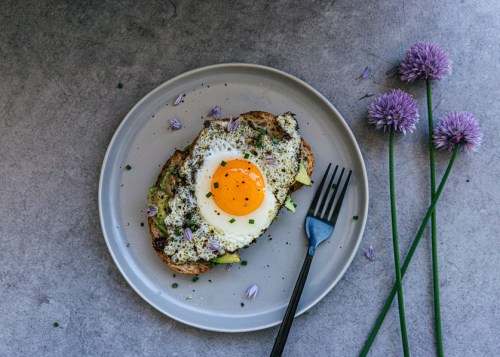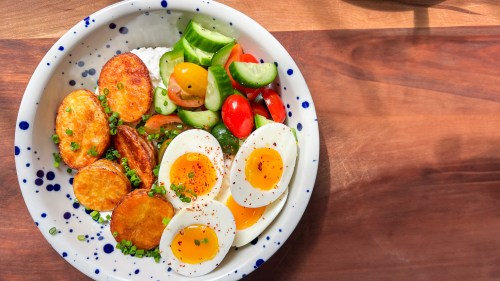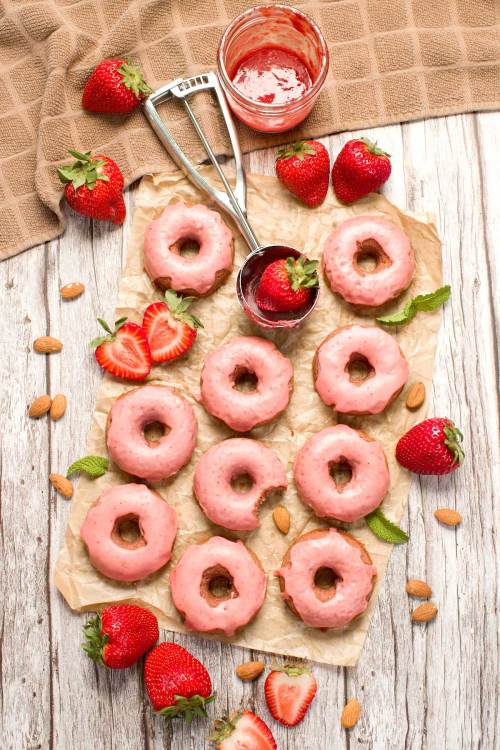Our editors independently select these products. Making a purchase through our links may earn Well+Good a commission
Avocado Toast Doesn’t Pack Enough Protein or Fiber To Be Considered a Well-Rounded Breakfast—Here’s What RDs Rec Eating With It
A dietitian explains why there isn't enough fiber or protein in avocado toast to call it a well-rounded breakfast and how to boost them.

Avocado toast has remained one of the most Instagram-ed foods for years now, coming of age alongside the platform itself, and we love seeing the many ways people love to serve this dish up around the world. And while nutrient-rich, dietitians say that even the most beautiful and generous plates of avocado toast usually aren’t cutting it in both the fiber and protein departments to be considered a well-rounded breakfast with the ability to power you through a busy day. Most end up offering only enough nutrients to be a hearty snack at best, especially since the amount of protein in avocado isn’t much. We asked Vanessa Rissetto, MS, RD, CDN, co-founder and co-CEO of Culina Health, everything we need to know about starting our day with the right protein-fiber balance in order to have our avocado toast and eat it, too.
Experts in This Article
registered dietitian and CEO and co-founder of Culina Health
Is avocado toast a good source of protein?
When it comes to how much protein we should aim for at breakfast time, Rissetto says she gets pretty individualized with her clients based on their age, lifestyle, and health goals—but targeting 30 grams at each meal when possible is a good rule of thumb. She also takes into consideration the complexities around breakfast, as clients may prefer to follow a cultural pattern they grew up with, grab something on-the-go to meet a hectic schedule, or eat later in the morning, among many other possibilities. And while Rissetto says avocado toast is a great pick if that’s what you love to start your day with (especially when you’re trying to use up an avocado to keep it from turning brown, even though a brown avocadois totally safe to eat in most cases), you may need to add something beyond some bread, sliced (or smashed) avocado, and a pretty garnish to get enough protein.
How much protein is in an avocado toast?
In short: Avocado toast on its own definitely doesn’t supply an adequate amount of protein to be considered an entire meal. “Avocado toast is fine for breakfast, but if you want to stay full until lunch, then you’ll have to add something else,” Rissetto says. “We need protein, fat, and carbs at each meal to slow down digestion, stabilize our blood sugar, and keep us full.” A slice of avocado toast made with whole wheat bread and a half of an avocado contains roughly five grams of protein, which certainly falls short of the 30 gram mark. But, not to worry, there are tons of easy ways to up the protein intake to turn avocado toast from snack to full-blown entree with the help of a few protein-packed ingredients. (Think: Eggs, cheese, chickpeas, black beans, this list goes on and on.)
Easy ways to up the protein in avocado toast
Upping the protein in avocado toast doesn’t necessarily mean adding a lot of work to your meal prep routine. In fact, in most cases, protein boosters are single-ingredient wonders that require minimal, if no, work or *cooking* to make. Some of Rissetto’s top picks for packing in some extra protein include topping avocado toast with an egg or two, scrambled tofu, or even some sizzled halloumi cheese with a side of roasted chickpeas. Additionally, you could serve up a side of sausage or another protein-rich meat to help you hit that 30-gram mark with ease.
Cottage cheese is another easy way to add a boatload of protein to just about any meal. For context, Good Culture’s Low-Fat, 2 Percent Milkfat Classic Cottage Cheese—which we previously ranked as the overall best type of cottage cheese—has a whopping 14 grams of protein per half-cup serving. And given its sudden rise in popularity—cottage cheese strawberry ice cream to lasagna to homemade bread… it’s everywhere—it might be one of your best bets. Plus, if eating avocados is the root cause of your gut issues, cottage cheese toast might be the perfect post-workout appetizer and avo toast replacement. Not to mention, it’s beyond easy to make and perhaps even safer than cutting open an avocado. Ever heard of “avocado hand”? We sincerely hope not.
That said, although we know that consuming enough protein is vital for so many reasons—especially when it comes to establishing a well-balanced diet to build muscle, and support healthy organ and immune function—hitting the 30-grams-of-protein-per-meal mark daily isn’t always simple as we may hope. To make things easier, this 30 grams of protein cheat sheet is extremely useful to refer to when meal prepping. It includes simple protein-packed suggestions to help up the intake of this nutrient in just about any dish. This includes options like one cup of cottage cheese, two cups of black beans, or five eggs which all meet the 30-grams quota. Done and done.
Getting plenty of fiber is key, too
Indeed, it’s not all just about the protein. Getting plenty of fiber is critical, too. The good news about fiber is that we do have a pretty standard recommendation for adults—approximately 28 grams per day—though some health experts suggest even higher values. That means we should try to sneak in about nine grams at each meal, and unfortunately, nearly all of America is falling short of that. However, Rissetto says it’s important to not just hit this goal but to also get a diversity of fiber sources to ensure proper gut health and more satisfying meals.
“The thing about fiber is that it’s elusive and people don’t often understand how much they need and what kinds are right for them,” says Rissetto. “Generally, we want to aim for around 30 grams but need a mix of both soluble and insoluble fiber.”
Risetto explains that insoluble fiber helps create our bulk stool while soluble fiber helps it move throughout the digestive tract to complete a bowel movement. Gel-like soluble fiber helps to slow digestion which helps us feel more satiated, energized, and steady, thanks to balanced blood sugar levels, while insoluble fiber can actually speed up digestion, which can be helpful for those dealing with constipation.
Some of Rissetto’s favorite sources of insoluble fiber include whole grains and psyllium husk, and she loves nuts and seeds as top sources of soluble fiber. However, some foods can pack in both types, like oats. Just be sure to ease into increasing your fiber intake instead of packing on an extra 15-20 grams all at once, which can actually end up upsetting your digestive tract.
Opting for a hearty, sprouted or whole-grain bread will not only up the fiber count of your breakfast, but it may even pack in a few grams of plant protein as well. Rissetto says that seeds, like chia and flax, are some of the best sources of fiber out there, so serving your avocado toast with a side of chia pudding could do the trick in helping you stay full for hours. Plus, you can always serve up a side of roasted veggies or a veggie-rich hash to help make your breakfast more satisfying and colorful. Note: According to the USDA, one avocado contains roughly 13.5 grams of fiber, which isn’t too shabby on its own.
TL; DR? Simply making a few easy upgrades will transform your favorite avocado toast into the ultimate day-starter that will leave you feeling more nourished, balanced, and regular. Or you can always supplement your avo toast with a big ol’ bowl of high-protein cereal.
A registered dietitian shares the top sources of vegetarian and vegan protein:
Sign Up for Our Daily Newsletter
Get all the latest in wellness, trends, food, fitness, beauty, and more delivered right to your inbox.
Got it, you've been added to our email list.










